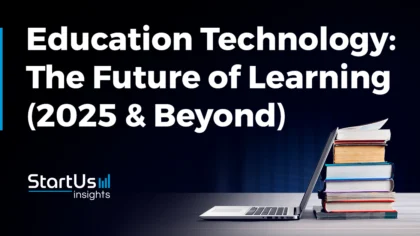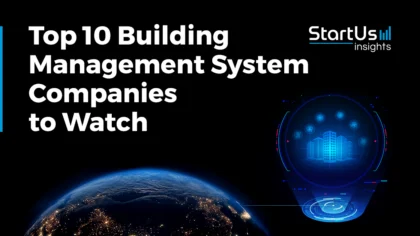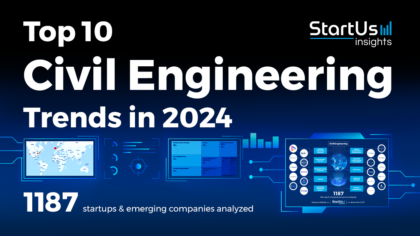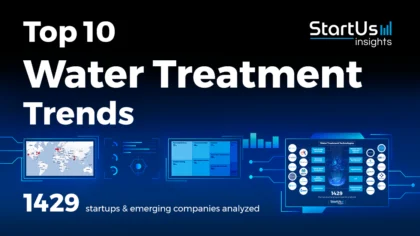Education technology is driving major changes through artificial intelligence (AI) that offers personalized learning, automates tasks, and boosts engagement. Augmented reality (AR) and virtual reality (VR) bring subjects to life with immersive simulations while big data drives better outcomes by offering insights into student performance. Further, blockchain offers secure record management and cleantech promotes sustainability on campuses. Continue reading to explore how each technology is redefining classrooms and unlocking new opportunities for students and educators alike.
Why should you read this report?
- Gain in-depth insights into the top 10 technologies impacting education.
- Learn about three practical use cases for each technology.
- Meet 10 innovative startups advancing these technologies.

Key Takeaways
- Artificial Intelligence
- Use Cases:
- Personalized Learning Paths
- Automated Grading Systems
- Virtual Tutors
- Startup to Watch: Blended
- Use Cases:
- Internet of Things (IoT)
- Use Cases:
- Smart Attendance Systems
- Automated Resource Management
- Campus Safety and Security
- Startup to Watch: MantisEDU
- Use Cases:
- Advanced Robotics
- Use Cases:
- STEM Education Enhancement
- Assistive Learning Devices
- Computational Thinking for Children
- Startup to Watch: Teqdise
- Use Cases:
- Biometrics
- Use Cases:
- Secure Access Control
- Biometric Payments in School Cafeterias
- Attendance and Exam Authentication
- Startup to Watch: Indinatus
- Use Cases:
- Augmented Reality & Virtual Reality
- Use Cases:
- Immersive Learning Environments
- Virtual Field Trips
- Skill Development Simulations
- Startup to Watch: GeniusX
- Use Cases:
- Blockchain
- Use Cases:
- Credential Verification
- Decentralized Learning Platforms
- Student Record Management
- Startup to Watch: Blockskillo Education Technologies
- Use Cases:
- Big Data & Analytics
- Use Cases:
- Student Performance Tracking
- Curriculum Optimization
- Predictive Analytics for Dropout Prevention
- Startup to Watch: AnalyticVue
- Use Cases:
- CleanTech
- Use Cases:
- Green Campus Initiatives
- Solar-Powered Classrooms
- Water Conservation
- Startup to Watch: Seedling
- Use Cases:
- Cloud Computing
- Use Cases:
- Scalable Learning Management Systems (LMS)
- Data Security and Privacy in Education
- Remote Learning Infrastructure
- Startup to Watch: Si6 Associates
- Use Cases:
- Connectivity Technologies
- Use Cases:
- Augmented Reality in Education
- IoT-Enabled Smart Classrooms
- Real-Time Interactive Learning
- Startup to Watch: Accelecom
- Use Cases:
Education Technology FAQs
What are the future trends in education technology?
Future educational technology trends include AI and machine learning integration. They automate administrative tasks so that educators spend more time teaching. Gamification makes learning more engaging and allows students to stay motivated while micro-credentialing increases student focus. Besides, the proliferation of online and remote learning platforms makes education easily accessible.
How to overcome technology challenges in education?
To address technology bottlenecks in education, institutions prioritize infrastructure upgrades. Reliable internet access is vital for successful online learning, particularly in remote areas. Educator training programs are also crucial for achieving expertise in the use of emerging technologies. Collaboration with technology suppliers for partnerships allows educational institutions to incorporate tools into classrooms.
How We Identify Emerging Education Technologies & Startups
The data in this report originates from StartUs Insights’ Discovery Platform, covering 4.7 million global startups, scaleups, and technology companies, alongside 20000 emerging technology trends. Our platform makes startup and technology scouting, trend intelligence, and patent searches more efficient by providing deep insights into the technological ecosystem. Utilizing the trend intelligence feature, we analyze industry-specific technologies for this report, detect patterns and trends, and identify use cases along with the startups advancing these areas. Further details and capabilities are accessible via the website.
10 Emerging Education Technologies Impacting the Industry
1. Artificial Intelligence

Traditional education overlooks diverse learning needs. AI analyzes student data and customizes content to enable adaptive learning and improve engagement. Since educators struggle with time constraints from administrative tasks like grading and record management, AI-driven tools automate grading and other administrative functions. Further, AI-powered tools align scheduling, attendance tracking, and record management. By integrating these AI solutions, the education sector improves scalability, personalization, and efficiency.
3 Practical Use Cases of Artificial Intelligence in Education
- Personalized Learning Paths: AI-driven platforms tailor educational content to each student’s learning style and pace. This approach improves individual learning outcomes by addressing specific needs and gaps.
- Automated Grading Systems: Automate the assessment of student work and provide instant feedback. This reduces the administrative burden on educators and speeds up the grading process.
- Virtual Tutors: Offer on-demand academic support and personalized instruction to provide students with additional assistance outside of regular classroom hours.
Startup to Watch: Blended
Blended offers Blended OS, an AI-centric school operating system that unifies K-12 learning and management processes. It combines learning management systems (LMS) and student information systems (SIS) into a single platform. The system also utilizes AI to streamline content generation as well as enable cognitive analysis and personalized learning experiences. This optimizes school operations and supports autonomous learning, enhancing educational efficiency and student engagement.
2. Internet of Things

IoT sensors monitor and adjust classroom conditions to maintain a comfortable learning environment. Also, tailoring educational experiences to individual students’ needs can be difficult. IoT-enabled interactive whiteboards and tablets provide real-time feedback and adapt to educational content based on individual student performance. Further, IoT-enabled resource management tools assist administrators in tracking attendance and managing resources. Through these applications, IoT drives efficiency in the educational experience.
3 Practical Use Cases of the Internet of Things in Education
- Smart Attendance Systems: Use biometrics or RFID to automate and track student attendance efficiently. This allows educators to manage administrative tasks, reduce errors, and provide accurate attendance records for better student monitoring and resource allocation.
- Automated Resource Management: Allows educators to manage and allocate educational resources like textbooks and lab equipment using data analytics and automation. This ensures optimal resource use, reduces waste, and supports more effective learning.
- Campus Safety and Security: Connected devices monitor and protect educational facilities by providing real-time alerts and actionable insights to prevent incidents and respond swiftly to emergencies.
Startup to Watch: MantisEDU
MantisEDU offers IoT kits, probes, and sensors to transform classrooms, camps, or after-school programs into interactive, hands-on learning environments. The company combines real-time data collection and analysis for students to explore and experiment with various scientific concepts. The kits provide plug-and-play connectivity to ensure easy integration with existing learning modules. This approach engages students in immersive experimental learning, fostering curiosity and creativity, while providing educators with tools to enhance STEM education and promote a deeper understanding of IoT applications in real-world scenarios.
3. Advanced Robotics

Educational institutions often face challenges in managing administrative tasks efficiently. Robotic solutions automate repetitive tasks like data entry and scheduling to ease the workload for staff. Additionally, educational robotics kits offer hands-on STEM activities to provide interactive tools for students. To counter teacher shortages, virtual teaching assistants support classrooms by offering supplementary instruction. Further, integrating robotics into education promotes personalized learning and improves administrative efficiency.
3 Practical Use Cases of Advanced Robotics in Education
- STEM Education Enhancement: Robotic kits and programming teach key science and engineering concepts. This hands-on approach boosts student engagement and develops critical thinking and problem-solving skills.
- Assistive Learning Devices: Provide personalized support for students with disabilities, such as adaptive robots for communication and mobility. These devices improve educational accessibility by creating a more inclusive and tailored learning environment.
- Computational Thinking for Children: Robotics fosters computational thinking in children by allowing them to design, code, and debug robots to develop logical reasoning and problem-solving abilities. This approach prepares students for future tech careers.
Startup to Watch: Teqdise
Teqdise offers an educational robot, Jade Robot. It offers interactive and engaging learning experiences for children. The robot integrates into educational environments to provide hands-on coding lessons that make abstract concepts more tangible. By combining robotics with STEAM education, the Jade Robot improves students’ problem-solving skills and fosters enthusiasm for technology.
4. Biometrics

Verification during online examinations and attendance is difficult in virtual classes. To tackle this, facial recognition solutions allow schools and universities to authenticate the right participants and prevent identity fraud. Schools also face challenges in controlling access to restricted places, such as libraries and labs. Iris and fingerprint scanners offer strong security against unwanted access. During remote sessions, voice recognition on e-learning platforms also guarantees identity verification. Lastly, behavioral biometrics solutions track mouse and keyboard motions to identify unnatural or malicious activities and prevent fraud in virtual settings.
3 Practical Use Cases of Biometrics Technology in Education
- Secure Access Control: Biometrics solutions employ fingerprint or facial recognition systems to manage entry to school facilities. This ensures that only authorized individuals access sensitive areas, thus protecting students and staff.
- Biometric Payments in School Cafeterias: Allow students to pay for meals using their biometric data, such as fingerprints. This technology streamlines payments, reduces transaction times, and minimizes the risk of fraud.
- Attendance and Exam Authentication: Biometric systems verify student identities to prevent cheating, and ensure accurate records. This strengthens academic integrity and ensures fair evaluations.
Startup to Watch: Indinatus
Indinatus provides security solutions for educational campuses and school buses. It integrates high-definition video surveillance, real-time GPS tracking, and intelligent analytics to improve campus safety and prevent incidents. The company also offers technology that monitors entrances, hallways, and classrooms. Further, it features automatic number plate recognition and face image libraries to improve security measures. This way, Indinatus allows effective response to threats and emergencies.
5. Augmented Reality & Virtual Reality

Augmented reality and virtual reality improve student engagement, practical training, and remote learning. AR-powered textbooks overlay digital content on physical pages to make complex concepts more engaging and interactive. Meanwhile, VR platforms provide immersive simulations for fields like medicine and engineering as well as enable virtual field trips to historical sites and museums. AR tools improve remote learning by projecting digital content into students’ environments through smartphones or tablets. Integrating these technologies improves the quality and accessibility of education.
3 Practical Use Cases of AR & VR in Education
- Immersive Learning Environments: AR and VR create interactive and engaging educational settings for students to explore subjects in a virtual space. This immersive experience improves their understanding and retention of complex concepts.
- Virtual Field Trips: Allow students to experience educational excursions from their classrooms. This access broadens learning opportunities and exposes students to diverse environments and cultures.
- Skill Development Simulations: AR and VR offer realistic simulations for practicing practical skills. This hands-on approach prepares students for real-world applications and improves their proficiency.
Startup to Watch: GeniusX
GeniusX offers Retreat, a VR platform for education. This immersive environment engages students through interactive content, like audio, visual, and kinesthetic learning. Retreat allows students to grasp concepts faster while boosting confidence and focus. It also features customizable virtual classrooms and evergreen content to support various students.
GeniusX offers a virtual reality platform to enhance coaching sessions, distance learning, and retreats. It converts educational content into engaging learning environments. The platform enables customized group classrooms and interactive learning to provide real-time collaboration and experiential learning opportunities. This approach strengthens student engagement and knowledge retention while allowing educators to create dynamic, emotionally impactful courses.
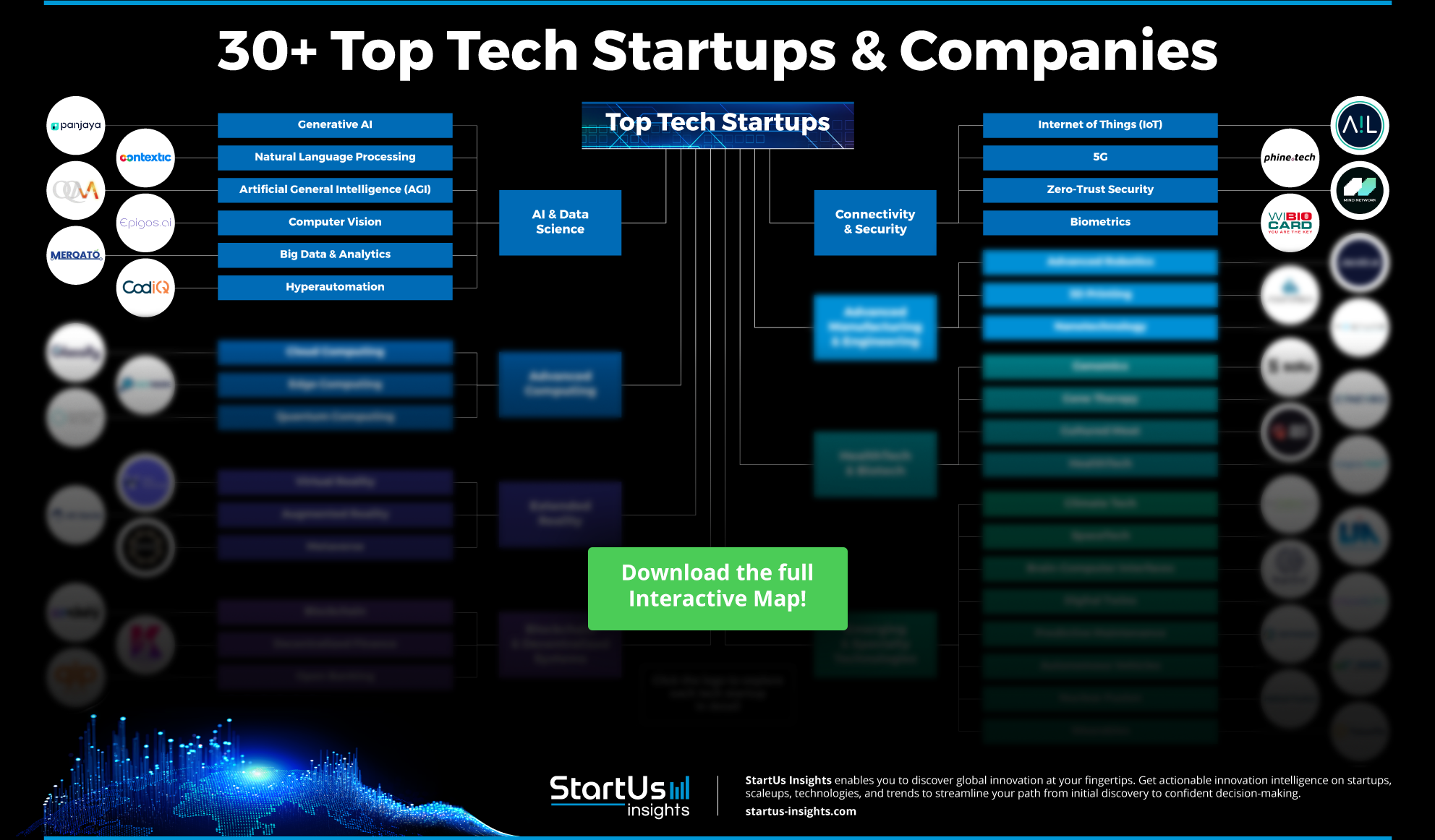
6. Blockchain

Blockchain addresses data security and credential verification issues in the education sector. Decentralized ledger systems offer tamper-proof records of academic achievements to reduce the risk of fraud. Smart contracts align administrative processes by automating tasks like enrollment and financial aid. Tokenization of credentials further allows for secure, verifiable issuance and management of degrees and certificates. Digital wallets facilitate the secure storage and easy sharing of academic records for students and employers. As educational institutions adopt blockchain, they improve record accuracy, protect against data breaches, and strengthen the industry’s operations.
3 Practical Use Cases of Blockchain in Education
- Credential Verification: Blockchain offers secure and immutable verification of academic credentials and certifications. This benefits the education industry by reducing fraud and aligning the verification process.
- Decentralized Learning Platforms: Create distributed, transparent educational ecosystems to provide greater access and equity in learning resources and foster innovative, peer-to-peer (P2P) educational interactions.
- Student Record Management: Blockchain ensures secure and tamper-proof management of student records and academic achievements. This increases data integrity and accessibility for students and institutions by simplifying record-keeping and reducing administrative overhead.
Startup to Watch: Blockskillo Education Technologies
Blockskillo Education Technologies offers a blockchain-based ed-tech platform that provides tamperproof certification and skill tokenization for blockchain courses. It uses blockchain technology to securely verify and validate student proficiency, ensuring authenticity and transparency. This approach ensures that learners receive comprehensive, verified training while gaining tokenized recognition to enhance their credibility and employability in the blockchain industry.
7. Big Data & Analytics

Big data and analytics are impacting how institutions gather insights, improve learning experiences, and make data-driven decisions. Technologies such as machine learning, predictive modeling, and AI play a significant role in analyzing vast amounts of educational data to identify trends, optimize resource allocation, and enhance student outcomes. This fosters a more inclusive and effective educational environment. Additionally, advanced visualization techniques, such as interactive dashboards and heat maps, enable educators and administrators to interpret complex data sets and make informed decisions.
3 Practical Use Cases of Big Data & Analytics in Education
- Student Performance Tracking: Big data and analytics monitor and evaluate student performance over time to identify trends, tailor interventions, and support student success.
- Curriculum Optimization: Analytics tools assess the effectiveness of curricula and teaching methods. By providing data-driven recommendations, these tools refine educational strategies for better outcomes.
- Predictive Analytics for Dropout Prevention: Predictive analytics tools analyze student behavior patterns to predict potential dropouts. This proactive approach offers timely interventions to support at-risk students and improve retention rates.
Startup to Watch: AnalyticVue
AnalyticVue develops a secure, cloud-based platform that converts raw K12 data from various district systems into actionable insights for better student outcomes. It SIS, LMS, and third-party assessments into a user-friendly interface. The platform features customizable dashboards for clear visualizations of key metrics for users to sort, filter, and create cohort groups for targeted analysis. AnalyticVue supports educators and administrators with a scalable software-as-a-service solution that offers data security and privacy.
8. CleanTech

Educational institutions incur high energy costs for lighting, heating, cooling, and electronic devices. Installing energy-efficient LED lighting and solar power systems reduces reliance on conventional sources and cuts energy expenses. Upgrading to low-flow faucets and toilets further decreases water usage and waste. Additionally, implementing waste sorting and recycling systems in schools and universities reduces the overall carbon footprint. By adopting cleantech solutions, educational institutions bring operational efficiency and environmental stewardship within their communities.
3 Practical Use Cases of CleanTech in Education
- Green Campus Initiatives: Support sustainability efforts through energy-efficient technologies and waste reduction on educational campuses. These initiatives create environmentally responsible institutions and educate students on sustainability practices.
- Solar-powered Classrooms: Solar power systems provide renewable energy to classrooms by reducing reliance on traditional energy sources. This lowers energy costs and promotes green technology adoption in schools.
- Water Conservation: Schools use smart water management systems, rainwater harvesting, and low-flow fixtures to minimize water wastage. These solutions reduce water bills and serve as live demonstrations of water conservation principles for students.
Startup to Watch: Seedling
Seedling provides hydroponics modules for educational institutions. Further, it offers youth programs focused on food and STEM literacy. The company’s hydroponic units, including a 5-quart deep water system and mason jar units, offer year-round fresh produce growth in classrooms and homes. These units support resource-saving agriculture by minimizing water and resource use.
9. Cloud Computing

Students and educators struggle to access resources and maintain engagement in remote learning. To tackle this, cloud computing provides scalable storage for managing educational content and student data. Moreover, cloud-based LMS solutions manage courses, track progress, and facilitate online assignments and exams. These secure solutions protect sensitive student information and offer compliance with data privacy regulations while allowing institutions to scale quickly. Additionally, cloud computing improves efficiency and supports personalized learning through real-time updates and access to diverse applications and services.
3 Practical Use Cases of Cloud Computing in Education
- Scalable Learning Management Systems (LMS): Cloud computing allows the deployment of scalable LMS platforms that accommodate a growing number of users and resources. This provides flexible, on-demand access to learning materials and administrative tools.
- Data Security and Privacy in Education: Cloud solutions improve data security and privacy through encryption and compliance measures. This approach protects sensitive student information and ensures adherence to regulatory standards.
- Remote Learning Infrastructure: Cloud computing supports robust remote learning environments with reliable access to digital resources and virtual classrooms. This encourages continuity of education and expands learning opportunities beyond traditional classroom settings.
Startup to Watch: Si6 Associates
Si6 Associates offers an all-in-one education platform for managing the entire student lifecycle. Its technology combines CRM, admissions, enrollment, study, LMS, assessment, certification, and analytics into a configurable student information system. This platform serves K-12, vocational, and higher education institutions, including trusts with multiple institutions. With a cloud-native architecture, it features a no-code application form builder for rapid integration. The company also improves SAP systems with add-on solutions that automate processes and align with industry best practices.
10. Connectivity Technologies

Connectivity technologies are improving education by improving access to high-speed internet and digital devices, especially for underserved areas. 5G networks bring fast internet to remote regions reduce the digital divide and expand access to online resources. As a result, learners are able to access cloud-based learning platforms while educators benefit from simplified resource distribution and on-demand educational tools. High-bandwidth Wi-Fi ensures smooth virtual class participation. Together, these technologies overcome traditional learning barriers and create a more inclusive and effective education system.
3 Practical Use Cases of Connectivity Technologies in Education
- Augmented Reality in Education: AR is data and processing-intensive, and hence needs high-speed connectivity to function properly. For instance, 5G features low-latency connectivity to enable real-time interactions in immersive learning.
- IoT-Enabled Smart Classrooms: Integrate various devices and sensors to optimize learning environments through data-driven insights. This technology improves educational outcomes by automating classroom management and providing real-time feedback.
- Real-Time Interactive Learning: Uses digital tools for live, collaborative experiences. It allows immediate feedback and dynamic interactions to boost participation and outcomes.
Startup to Watch: Accelecom
Accelecom delivers fiber-optic network solutions for digital learning environments. The company’s fiber network utilizes high-capacity infrastructure to offer dedicated Ethernet and high data transmission speeds across urban and rural areas. Accelecom’s network, built with ring architecture for high availability, offers secure connectivity essential for continuous cloud access. Its solutions, including dark fiber, Ethernet, wavelength services, and managed services, support educational needs such as remote student enablement, digital inclusion, and more.
Don’t Miss Out on the Latest Education Technologies
With StartUs Insights, you swiftly discover hidden gems among over 4.7 million startups, scaleups, and tech companies, supported by 20,000 trends and technologies. Our AI-powered search and real-time database ensure exclusive access to innovative solutions, making the global innovation landscape easy to navigate. Trusted by industry leaders like Samsung, Nestlé, and Magna, we provide unmatched data, a 360-degree industry view, and data-driven intelligence for confident strategic decisions. Leverage our innovation services to optimize costs, streamline operations, and stay ahead of the curve. Get in touch today to explore how our comprehensive innovation intelligence can drive your success.
Discover All Emerging Education Technologies & Startups!
